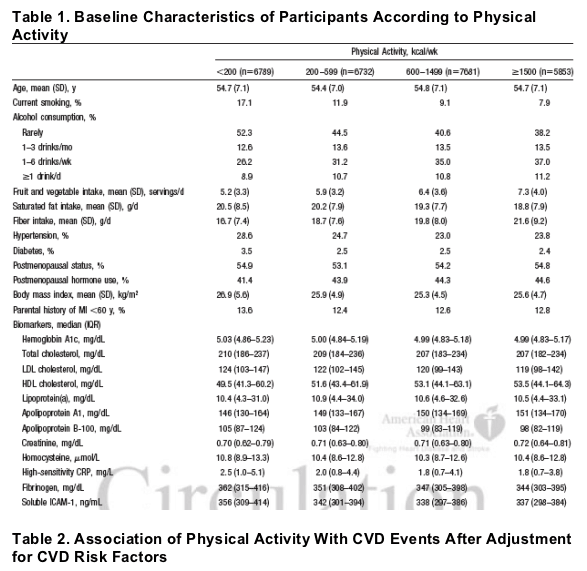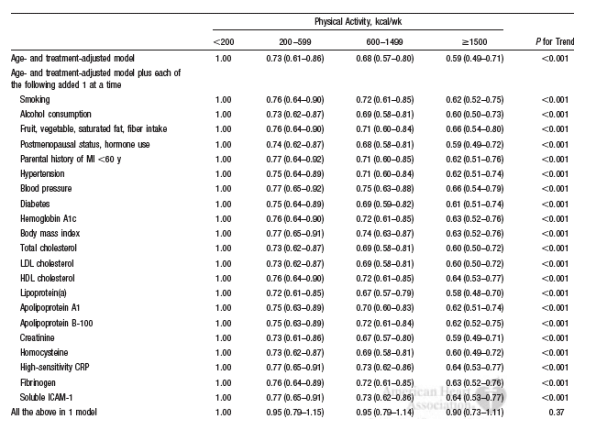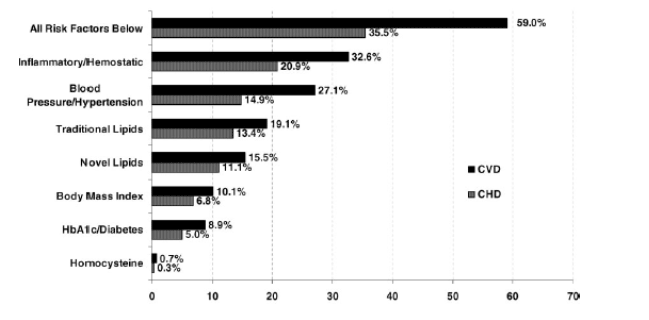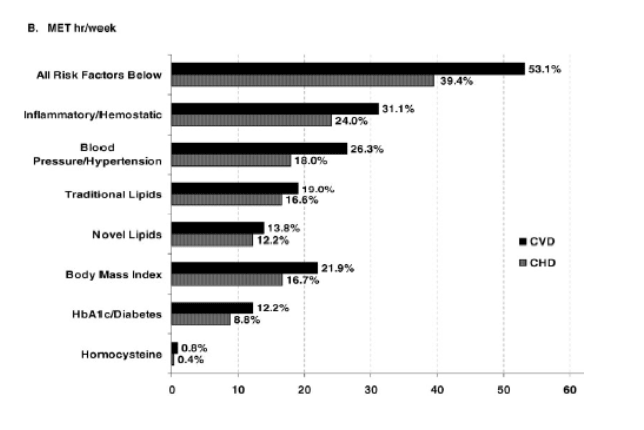| |
Physical Activity and Reduced Risk of Cardiovascular Events Potential Mediating Mechanisms
|
| |
| |
Circulation Oct 22, 2007 (Jnl of the American heart Association)
Samia Mora, MD, MHS; Nancy Cook, ScD; Julie E. Buring, ScD;
Paul M Ridker, MD, MPH; I-Min Lee, MBBS, ScD
Background-Higher levels of physical activity are associated with fewer cardiovascular disease (CVD) events. Although the precise mechanisms underlying this inverse association are unclear, differences in several cardiovascular risk factors may mediate this effect.
Methods and Results-In a prospective study of 27 055 apparently healthy women, we measured baseline levels of hemoglobin A1c, traditional lipids (total, low-density lipoprotein, and high-density lipoprotein cholesterol), novel lipids
[lipoprotein(a) and apolipoprotein A1 and B-100], creatinine, homocysteine, and inflammatory/hemostatic biomarkers (high-sensitivity C-reactive protein, fibrinogen, soluble intracellular adhesion molecule-1) and used women's self-reported physical activity, weight, height, hypertension, and diabetes.
Mean follow-up was 10.9±1.6 years, and 979 incident CVD events occurred. The risk of CVD decreased linearly with higher levels of activity (P for linear trend
<0.001). Using the reference group of <200 kcal/wk of activity yielded age- and treatment-adjusted relative risk reductions associated with 200 to 599, 600 to 1499, and >/=1500 kcal/wk of 27%, 32%, and 41%, respectively.
Differences in known risk factors explained a large proportion (59.0%) of the observed inverse association. When sets of risk factors were examined, inflammatory/hemostatic biomarkers made the largest contribution to lower risk (32.6%), followed by blood pressure (27.1%). Novel lipids contributed less to CVD risk reduction compared with traditional lipids (15.5% and 19.1%, respectively). Smaller contributions were attributed to body mass index (10.1%) and hemoglobin A1c/diabetes (8.9%), whereas homocysteine and creatinine had negligible effects ( 1%).
Conclusions-The inverse association between physical activity and CVD risk is mediated in substantial part by known risk factors, particularly inflammatory/hemostatic factors and blood pressure.
Physical activity or fitness clearly reduces the risk of cardiovascular disease (CVD), with a magnitude of risk reduction comparable to that of not smoking.1,2 However, the precise mechanisms through which physical activity lowers CVD risk are not well understood. Even after traditional cardiovascular risk factors such as blood pressure, lipids, and diabetes are accounted for, the inverse relation between physical activity and CVD risk persists.3-7 Changes in individual risk factors with physical activity tend to be modest, on the order of 5% for blood lipids,8,9 3 to 5 mm Hg for blood pressure,10,11 and 1% for hemoglobin A1c,12 in contrast to the large reductions (30% to 50%) in CVD risk seen with physical activity.
Clinical Perspective
The relative contribution of these various risk factors, representing a number of physiological pathways, to the activity-related risk reduction in CVD is unknown. In addition, newly recognized CVD risk factors, in particular those relating to inflammation and hemostasis, also are modified favorably with physical activity.13-18 This likely represents an additional mechanistic pathway through which physical activity decreases CVD risk. Therefore, the aim of the present
study was to quantify the contribution of traditional and novel risk factors to the activity-related reduction in CVD.
Study Population
Study participants were drawn from the Women's Health Study (WHS), a recently completed trial of low-dose aspirin and vitamin E in the primary prevention of CVD in women.19-21 WHS participants were apparently healthy female healthcare professionals 45 years of age who were free of self-reported CVD and cancer at study entry (1992 to 1995). Women gave written informed consent and completed questionnaires at the time of enrollment on demographics,
anthropometrics, medical history, medications, and lifestyle factors. They also were asked to provide a blood sample; 28 345 women did so. For this study, we excluded women with missing data on physical activity or body mass index (n 544) or missing information on the traditional or novel biomarkers of interest (n 433), leaving 27 055 women for analysis. The study was approved by the Institutional Review Board of the Brigham and Women's Hospital (Boston,
Mass).
Statistical Analysis
Statistical analyses were performed with STATA version 8.2 (STATA Corp, College Station, Tex). We categorized participants into approximate quartiles of energy expenditure (<200, 200 to 599, 600 to 1499, and >/=1500 kcal/wk); the highest activity category corresponds to about 5 hours of moderate-intensity activity per week. 23 Cox proportional-hazard regression models were used to calculate the hazard ratios (HRs) and 95% confidence intervals (CIs) according to these activity groups. Tests for linear trend were performed using the median value for each activity group. All probability values were 2 tailed.
To examine the extent to which various CVD risk factors contributed to the risk reduction in events associated with activity, we initially considered each risk factor separately in a model that adjusted for age and randomized treatment assignment. We considered the magnitude of change in the HRs for the most active women compared with the least with and without adjustment for each risk
factor. A larger change in the HR toward the null implies a larger mediating effect of that risk factor on the activity-related reduction in CVD.
Then, on an a priori basis, we grouped together a set of variables that are generally considered to be potential confounders rather than mediators (smoking; dietary intake of alcohol, fruits, and vegetables; consumption of saturated fat and fiber; menopause; hormone use; and parental history of MI before 60 years of age). We included this set of variables, together with age and randomized treatment assignment, in a single model, referring to this model as the basic model.
Also on an a priori basis, we grouped other CVD risk factors generally considered to be potential mediators into sets of risk factors on the basis of their pathophysiological effects. Blood pressure and the presence or absence of hypertension were combined as 1 set. Hemoglobin A1c and the presence or absence of diabetes were combined as another set. To consider the combined effect of traditional lipids, we combined total, LDL, and HDL cholesterol into
1 set, with a similar analysis for novel lipids [lipoprotein(a), apolipoprotein A1 and B-100]. High-sensitivity CRP, fibrinogen, and soluble ICAM-1 were considered as a group related to inflammatory and hemostatic pathways. Finally, body mass index and homocysteine were examined separately.
To examine the extent to which CVD risk factors potentially mediated the effect of activity on incident CVD, we next added these risk factors, 1 set at a time, to the basic model and examined the magnitude of change in the HRs for the most active women compared with the least without (basic model) and with adjustment for each set of risk factors (adjusted model). Finally, we performed a fully adjusted analysis that included all the CVD risk factors simultaneously. The proportion of CVD risk reduction explained by each set of CVD risk factors was computed as follows24,25: (HRbasic model HRadjusted model)/(HRbasic model 1) 100%. The authors had full access to and take full responsibility for the integrity of the data. All authors have read and agree to the manuscript as written.
Assessment of Physical Activity and
CVD Risk Factors
Physical activity was assessed at study entry with a questionnaire that has been shown to be valid and reliable.22 The correlation of activity reported on the questionnaires compared with activity diaries kept for 4 weeks over a year was 0.62.22 Participants were asked to estimate the average time per week over the past year spent on 8 groups of recreational activities and the number of flights of stairs climbed daily.23 A metabolic equivalent task (MET) score was assigned to each activity on the basis of its energy cost. We estimated the energy expended on each of the above groups of activities and summed over all activities to estimate the total energy expended on physical activity (kcal/wk). We used kilocalories as the unit of energy expenditure because this unit is widely understood by physicians and patients. However, body weight is used in the
computation of energy expenditure in kilocalories per week (ie, for the same activity, a heavier person expends more kilocalories than a lighter person). Thus, we repeated analyses using energy expenditure estimated in MET-hours, a unit that is independent of body weight (ie, for the same activity, heavier and lighter persons expend the same MET-hours).
At study entry, participants also reported information on smoking, diet, menopausal status, hormone use, weight, height, blood pressure, history of hypertension (blood pressure 140/90 mm Hg or use of antihypertensive medication) and diabetes, and family history.
Results
Table 1 shows the baseline characteristics of participants according to their activity levels. Active women had a healthier lifestyle, weighed less, and had better risk factor profiles than inactive women. There were modest but statistically significant differences in all biomarkers except lipoprotein(a), with higher activity associated with better profiles (P for linear trend 0.001).
During a mean follow-up of 10.9+/-1.6 years, a total of 979 first CVD events occurred, including 640 CHD events (253 MIs, 398 percutaneous coronary interventions, and 219 coronary artery bypass grafts) and 266 ischemic strokes.
The risk of incident CVD decreased linearly with higher levels of activity (P for linear trend <0.001; Table 2). Using the reference group of 200 kcal/wk of activity and after adjusting for age and randomized-treatment assignment, we
found relative risk reductions associated with 200 to 599, 600 to 1499, and >/=1500 kcal/wk of 27%, 32%, and 41%, respectively. In separate Cox regression models that considered each risk factor variable, 1 at a time, and adjusted for age and treatment assignment (Table 2), there was some attenuation noted in the HRs comparing the most active women with the least active before and after adjustment for all variables, except for creatinine, lipoprotein(a), and postmenopausal status/hormone use. However, when all risk factors were combined in 1 model, the HR comparing the most active
women with the least active was substantially attenuated (after adjustment for all risk factors: HR, 0.90; 95% CI, 0.73 to 1.11; after adjusting for only age and treatment assignment: HR, 0.59; 95% CI, 0.49 to 0.71), and the linear trend across activity levels was no longer significant (P for linear trend=0.37).
Next, to determine the extent to which the reduced risk of CVD associated with activity was influenced by potential mediators representing various physiological pathways, each set of mediators was added, 1 set at a time, to the basic model
(Table 3, top). For CVD, the addition of blood pressure/hypertension resulted in an attenuation of the inverse relation, which became nonsignificant (P for trend=0.09), with similar results for the inflammatory/hemostatic biomarkers (P for trend=0.10). The addition of body mass index, hemoglobin A1c/diabetes, traditional lipids, and novel lipids, 1 set at a time, resulted in smaller attenuations in the inverse relation between activity and CVD (all P for trend
For CHD, a broadly similar pattern was observed (Table 3, bottom). Unlike CVD, there remained a borderlinesignificant inverse association with CHD after adjustment for all sets of risk factors (P for trend 0.05).
The associations of activity with nonfatal MI, percutaneous coronary intervention, and coronary artery bypass grafting, when examined as separate end points, are shown in Table 4. When the sets of potential mediators were added to the basic model, the effect of physical activity was attenuated in a manner similar to that seen with CHD. The association of activity with ischemic stroke was nonlinear (corresponding age- and treatment-adjusted HRs and 95% CIs: 1.00, 0.68 [95% CI, 0.49 to 0.95], 0.69 [95% CI, 0.50 to 0.95], and 0.72 [95% CI, 0.51 to 1.01],
respectively; P for trend 0.16).
Finally, we computed the proportion of the physical activity-related reduction in CVD or CHD events explained by each set of potential mediators (Figure). A large proportion (59.0%) of the inverse relation between physical activity and CVD risk was explained by the potential mediators that we investigated. When examined as sets of risk factors, inflammatory/hemostatic biomarkers were the largest contributors to lower risk (32.6%), followed by blood pressure (27.1%). Novel lipids [lipoprotein(a), apolipoprotein A1 and B-100] contributed less to CVD risk reduction than traditional lipids (total, LDL, and HDL cholesterol): 15.5% and 19.1%, respectively. Smaller contributions were attributed to body mass index (10.1%) and hemoglobin A1c/diabetes (8.9%), whereas homocysteine had negligible effects (<1%). A similar but smaller pattern was observed for CHD (35.5% of the CHD event risk reduction explained by risk factors compared with 59.0% for CVD).
We repeated our analyses (Figure, B), calculating activity expenditure in MET-hours per week instead of kilocalories per week. Almost identical results were obtained except for body mass index, the contribution of which increased from 10.1% to 21.9%, and hemoglobin A1c/diabetes, which increased from 8.9% to 12.2%.


Discussion
Although physical activity has clearly been shown to reduce the risk of developing CVD, the biological mechanisms underlying this association are unclear, as is the extent to which various pathways might underlie the inverse association. This study indicates that the association between higher levels of activity and lower CVD rates can be explained in large part by known risk factors, both traditional and novel. The risk factors investigated in this study explained 59.0% of the activity-related reduction in CVD, with inflammatory/ hemostatic biomarkers making the largest contribution to lowered risk, followed by blood pressure, lipids, and body mass index. A smaller contribution was attributed to measures of glucose abnormalities, with minimal contribution observed from measures of renal function or homocysteine.
The beneficial effect of physical activity was stronger for CHD compared with CVD in this study, but the relative contributions of potential mediators were proportional and qualitatively similar. Previous studies have noted nonlinear associations or weak or positive associations between activity and stroke,26,27 as did we.
Prior studies have demonstrated favorable effects of physical activity on traditional risk factors.9,28 -30 Although some individuals may experience large changes in risk factors with exercise,31 most individuals experience modest
short-term changes, on the order of 2% to 5%.8 -12 The effect of exercise on inflammatory factors has been recognized more recently.13,17,32 Acute bouts of exercise result in a transient, mostly proinflammatory, several-fold increase in acute-phase reactants and cytokines,33 proportional to the amount of exercise and muscle injury.32
In contrast, regular activity also has been associated with a chronic anti-inflammatory effect, with moderate (about 20% to 30%) reductions in CRP and soluble ICAM and vascular adhesion molecules.34,35 We previously demonstrated that in this population of women, the highest versus lowest level of activity was associated with about 43% lower high-sensitivity CRP level, which was mildly attenuated to 37% after adjustment for the other risk factors, including
body mass index.18 The mechanisms underlying the chronic antiinflammatory and hemostatic effects of exercise are not well defined and are only partially related to body weight.18,36 Other explanations include possible effects
on proatherogenic adipokines, insulin-sensitizing pathways, or the hemostatic and antioxidant functions of the coronary endothelium.32,37 Regular exercise attenuates the age-associated increase in oxidative stress and nuclear
factor- B activation in animals38 and reduces toll-like receptor 4 signaling, which may explain the chronic antiinflammatory effect of exercise.39-40
Several limitations of the present study warrant consideration. Physical activity and several of the risk factors were assessed by self-report. It is possible that more precise assessment of these factors may have resulted in a different contribution of these variables to the reduction in CVD risk. The study design was observational but prospectively collected. We did not have information on other
variables that are favorably influenced by physical activity, such as those related to heart rate or autonomic balance,41 baseline waist circumference or insulin sensitivity, 42 and nitric oxide- dependent endothelial activity,43 so we could not evaluate their contributions to the inverse relation between physical activity and CVD risk.
This study also has several strengths, including the large number of women investigated, detailed information on physical activity, a wide range of traditional and novel CVD risk factors, and the long duration of follow-up for the various
cardiovascular end points.
In summary, to the best of our knowledge, this is the first study to attempt to quantify the relative importance of potential underlying mechanisms through which higher levels of physical activity are associated with lower risk of CVD events. In this study, we have identified potential underlying mechanisms through which even moderate levels of physical activity (at least 600 kcal/wk, or the
equivalent of just over 2 h/wk of brisk walking, consistent with current guideline recommendations)44 are associated with lower risk of clinically important CVD events.
Modest changes in known CVD risk factors, particularly those relating to inflammation/hemostasis and blood pressure, account for a substantial portion of the benefit of physical activity on CVD risk and thus may have important downstream consequences for the primary prevention of CVD.
Figure. Percentage reduction in CVD events associated with physical activity that is explained by risk factors. The proportion of the risk reduction for >/=1500 kcal/wk of physical activity (versus the reference group of 200 kcal/wk; A) and for >20.5 MET h/wk (versus the reference group of <2.8 MET h/wk; B) that is explained by each set of potential risk factors calculated as follows: (HRbasic model HRadjusted model)/(HRbasic model 1) 100%.24 These proportions were calculated from HRs expressed up to 5 decimal points for greater accuracy and thus may differ slightly from the data shown in Table 3. HbA1c indicates hemoglobin A1c.


|
|
| |
| |
|
|
|